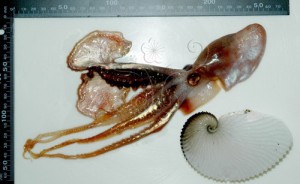TELDAP Collections
| Argonauta argo Linnaeus, 1758 扁船蛸 |
|
Introduction The argonauts are distributed in the tropical and subtropical oceans of the world. In recent years , these octopuses have been recorded to drift near the coasts of northern and north eastern Taiwan, such as documented in 2007 off the Northern Coast in Sanchih. For days numerous argonauts were stranded on the beach, amassing a huge gathering of sea shell aficionados to collect them. In addition, these octopuses have been sighted in the waters around Pingtung County's Siao Liouciou Island and Penghu areas. The Greater Argonaut is a cephalopod with clear display of sexual dimorphism. The females are larger in sizes than males, and only females construct shells . The shells are thin and brittle and are composed of calcite. It is secreted by the glands on the tips of the female's two specialized dorsal arms , and doubles as a hatching chamber and defense for the eggs. There is only one large cavity inside the shell, unlike the nautilus which has numerous chambers. The top of the shell retains some air which may aid its buoyancy. The female argonauts drift in the ocean by covering its shell with two sheets of elastic thin membranes expanding from their two specialized dorsal arms . They hide their mantles inside the case. The 3 rd arms on the right sides of male argonauts will develop into a worm-like hectocotylus, specialized sexual appendages that detach and cling onto the female argonauts after sexual reproductions. They are stored in a cyst like structure and protrudes from the cyst during sexual reproduction. One female argonaut can accept hectocotylus from different males; these appendages will survive for a while after detachment. The argonaut maneuvers its motion by expelling water from its siphon, and can manipulate the siphon to change its direction. Field diving records have shown that these octopuses may swim in packs; some may arrange in a curved formation, others may pull one another, with 5-6 argonauts in a row as a whole. During free roaming, the membranes sheathing the egg cases will display camouflage reflecting the color of the surroundings . The dorsal side may appear blue, while the ventral may appear silver white; when startled, they may change to an intense red. As a nocturnal organism, the argonaut is more active during night times. The activities of argonauts are related to the intensity of warm currents; when the currents are stronger, they will move closer to shores in packs.
National Museum of Natural Science
|













